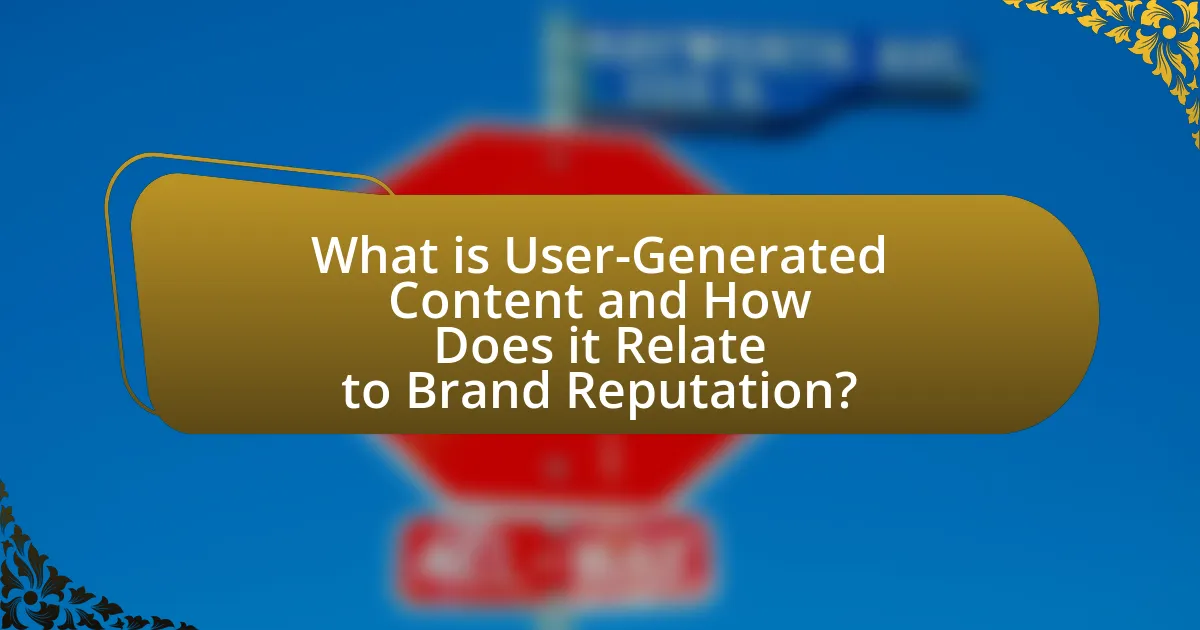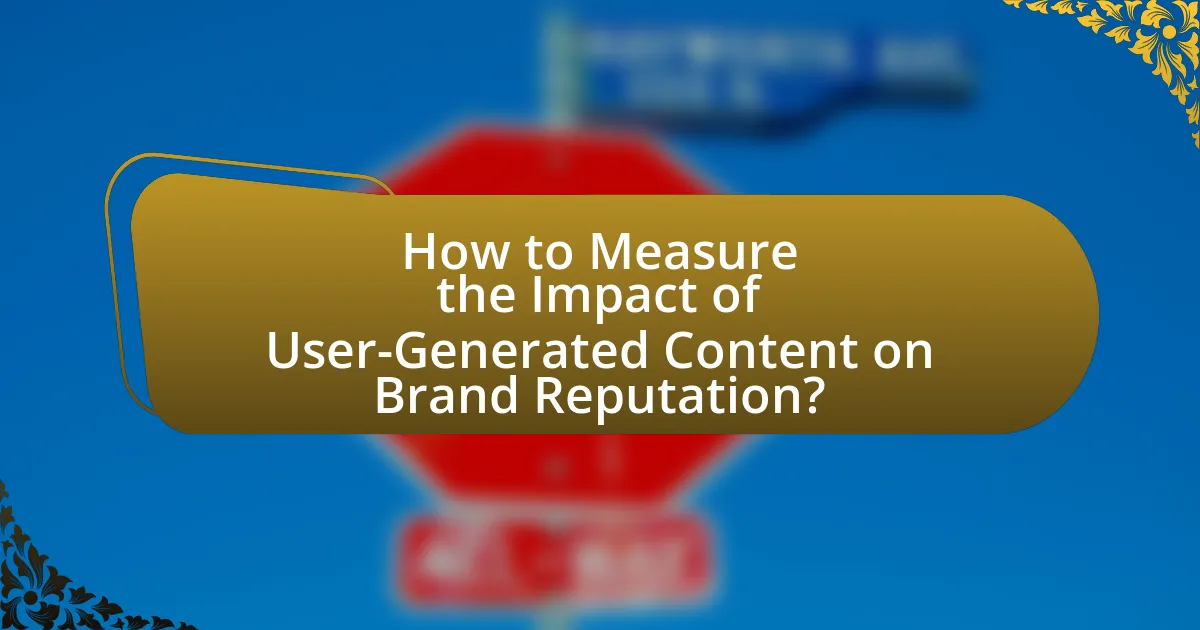User-Generated Content (UGC) is content created by consumers, such as reviews, images, and videos, which significantly influences brand reputation. This article explores the importance of UGC in fostering authenticity and trust among consumers, highlighting its impact on purchasing decisions and brand loyalty. It discusses various types of UGC that enhance brand reputation, strategies for brands to encourage and curate UGC, and the potential risks associated with its use. Additionally, the article outlines best practices for leveraging UGC effectively, including measuring its impact on brand perception and engagement.

What is User-Generated Content and How Does it Relate to Brand Reputation?
User-Generated Content (UGC) refers to any form of content, such as text, images, videos, or reviews, created by consumers or users rather than brands. UGC significantly impacts brand reputation as it serves as authentic endorsements from real customers, influencing potential buyers’ perceptions and trust. According to a study by Nielsen, 92% of consumers trust organic, user-generated content more than traditional advertising, highlighting its effectiveness in shaping brand image. Brands that actively engage with UGC can enhance their reputation by showcasing customer satisfaction and fostering community, ultimately leading to increased loyalty and sales.
Why is User-Generated Content Important for Brands?
User-generated content (UGC) is important for brands because it fosters authenticity and trust among consumers. Research indicates that 79% of people say user-generated content highly impacts their purchasing decisions, as it provides relatable and genuine insights into products or services. UGC enhances brand reputation by showcasing real customer experiences, which can lead to increased engagement and loyalty. Additionally, brands that incorporate UGC into their marketing strategies often see higher conversion rates, as potential customers are more likely to trust content created by their peers over traditional advertising.
What types of User-Generated Content can enhance brand reputation?
User-generated content that can enhance brand reputation includes customer reviews, testimonials, social media posts, and user-created videos. Customer reviews provide authentic feedback that builds trust, as 79% of consumers trust online reviews as much as personal recommendations. Testimonials showcase positive experiences, reinforcing credibility. Social media posts featuring a brand’s products create community engagement and visibility, with 70% of consumers more likely to trust a brand with user-generated content. User-created videos, such as unboxings or tutorials, offer relatable and engaging content that can increase brand loyalty and awareness.
How does User-Generated Content influence consumer trust?
User-Generated Content (UGC) significantly enhances consumer trust by providing authentic and relatable experiences shared by other consumers. Research indicates that 79% of people say user-generated content highly impacts their purchasing decisions, as it offers social proof and validation of a brand’s credibility. UGC, such as reviews, testimonials, and social media posts, creates a sense of community and transparency, making consumers feel more confident in their choices. This trust is further reinforced by the fact that 70% of consumers trust peer reviews over traditional advertising, highlighting the effectiveness of UGC in shaping perceptions and driving brand loyalty.
How can brands effectively leverage User-Generated Content?
Brands can effectively leverage User-Generated Content (UGC) by encouraging customers to share their experiences and showcasing this content across marketing channels. This approach not only builds trust but also fosters community engagement, as 79% of consumers say user-generated content highly impacts their purchasing decisions. By integrating UGC into social media campaigns, websites, and advertisements, brands can enhance authenticity and relatability, leading to increased customer loyalty and brand reputation.
What strategies can brands use to encourage User-Generated Content?
Brands can encourage User-Generated Content (UGC) by implementing strategies such as hosting contests, creating branded hashtags, and engaging with their audience on social media. Contests incentivize participation by offering rewards for the best submissions, which can significantly increase content creation; for example, a study by Tailwind found that brands using contests saw a 34% increase in UGC. Branded hashtags help organize and promote content, making it easier for users to share their experiences while increasing brand visibility. Engaging with the audience through comments and shares fosters a community feeling, encouraging more users to contribute content. These strategies collectively enhance brand reputation by showcasing authentic customer experiences.
How can brands curate and showcase User-Generated Content?
Brands can curate and showcase User-Generated Content (UGC) by actively engaging with their audience and utilizing various platforms to highlight customer contributions. This involves encouraging customers to share their experiences through social media, reviews, and testimonials, which can then be featured on the brand’s website, social media channels, or marketing materials. For instance, brands like Coca-Cola and Starbucks have successfully implemented UGC campaigns by creating hashtags that encourage customers to share their content, which not only increases engagement but also builds community and trust. Research indicates that 79% of people say user-generated content highly impacts their purchasing decisions, demonstrating the effectiveness of showcasing authentic customer experiences.

What are the Benefits of Leveraging User-Generated Content?
Leveraging user-generated content (UGC) enhances brand reputation by fostering authenticity and trust among consumers. UGC serves as social proof, demonstrating real customer experiences and satisfaction, which can lead to increased engagement and conversion rates. According to a study by Nielsen, 92% of consumers trust organic, user-generated content more than traditional advertising, highlighting its effectiveness in influencing purchasing decisions. Additionally, UGC can improve brand visibility and reach, as customers often share their content across social media platforms, amplifying brand exposure.
How does User-Generated Content improve brand visibility?
User-Generated Content (UGC) improves brand visibility by increasing engagement and trust among consumers. When customers create content related to a brand, such as reviews, photos, or videos, it generates authentic interactions that resonate with potential buyers. According to a study by Nielsen, 92% of consumers trust organic, user-generated content more than traditional advertising, which significantly boosts a brand’s credibility and reach. Additionally, UGC often gets shared across social media platforms, amplifying brand exposure and attracting new audiences. This organic sharing can lead to higher search engine rankings, further enhancing visibility.
What role does User-Generated Content play in social proof?
User-Generated Content (UGC) serves as a crucial element of social proof by providing authentic endorsements from real users, which enhances trust and credibility for brands. When potential customers see positive reviews, testimonials, or shared experiences from other consumers, they are more likely to perceive the brand as reliable and trustworthy. Research indicates that 79% of people say user-generated content highly impacts their purchasing decisions, demonstrating its effectiveness in influencing consumer behavior. This reliance on UGC as social proof underscores its role in shaping brand reputation and driving sales.
How can User-Generated Content enhance customer engagement?
User-Generated Content (UGC) enhances customer engagement by fostering a sense of community and trust among consumers. When customers share their experiences, reviews, or creative content related to a brand, it encourages interaction and participation from others, leading to increased engagement. According to a study by Nielsen, 92% of consumers trust organic, user-generated content more than traditional advertising, which highlights the credibility UGC brings to brand messaging. This trust translates into higher engagement rates, as customers are more likely to interact with content that feels authentic and relatable.
What are the potential risks of using User-Generated Content?
The potential risks of using User-Generated Content (UGC) include legal issues, brand reputation damage, and quality control challenges. Legal issues arise from copyright infringement, as users may not own the rights to the content they submit, leading to potential lawsuits. Brand reputation can suffer if UGC is inappropriate or misaligned with the brand’s values, as seen in cases where offensive content went viral, negatively impacting the brand’s image. Additionally, quality control challenges occur because UGC can vary significantly in quality, which may dilute the brand’s overall presentation and messaging. These risks necessitate careful monitoring and management of UGC to protect the brand’s interests.
How can brands mitigate negative feedback from User-Generated Content?
Brands can mitigate negative feedback from User-Generated Content by actively monitoring and responding to customer feedback in a timely manner. This approach allows brands to address concerns directly, demonstrating their commitment to customer satisfaction. Research indicates that 70% of consumers are more likely to recommend a brand that responds to their feedback, highlighting the importance of engagement. Additionally, brands can encourage positive User-Generated Content by incentivizing satisfied customers to share their experiences, thus overshadowing negative comments. Implementing a strategy that includes both proactive engagement and encouragement of positive contributions can significantly enhance a brand’s reputation.
What legal considerations should brands be aware of when using User-Generated Content?
Brands must ensure they have the appropriate rights to use User-Generated Content (UGC) to avoid legal issues. This includes obtaining explicit permission from the content creator, as copyright law protects original works, including images, videos, and text. Additionally, brands should be aware of the potential for defamation claims if the UGC contains false statements about individuals or entities. Furthermore, compliance with advertising regulations, such as disclosing sponsorships or endorsements, is crucial to maintain transparency and avoid misleading consumers. According to the U.S. Copyright Office, creators retain rights to their work unless they transfer those rights, emphasizing the importance of securing permissions.

How to Measure the Impact of User-Generated Content on Brand Reputation?
To measure the impact of user-generated content (UGC) on brand reputation, brands should analyze metrics such as sentiment analysis, engagement rates, and brand perception surveys. Sentiment analysis quantifies the emotional tone of UGC, revealing whether it is positive, negative, or neutral, which directly correlates with brand reputation. For instance, a study by Nielsen found that 92% of consumers trust user-generated content more than traditional advertising, indicating a strong influence on brand perception. Engagement rates, including likes, shares, and comments, provide insight into how UGC resonates with the audience, reflecting its effectiveness in shaping brand reputation. Additionally, conducting brand perception surveys before and after UGC campaigns can quantitatively assess changes in consumer attitudes towards the brand, providing concrete evidence of UGC’s impact.
What metrics should brands track to assess User-Generated Content effectiveness?
Brands should track engagement metrics, conversion rates, and sentiment analysis to assess User-Generated Content (UGC) effectiveness. Engagement metrics, such as likes, shares, and comments, indicate how well the content resonates with the audience. Conversion rates measure the percentage of users who take desired actions, such as making a purchase after interacting with UGC, providing insight into its impact on sales. Sentiment analysis evaluates the emotional tone of user comments and feedback, helping brands understand public perception and brand reputation. Collectively, these metrics provide a comprehensive view of UGC effectiveness and its influence on brand reputation.
How can brands analyze sentiment from User-Generated Content?
Brands can analyze sentiment from User-Generated Content (UGC) by employing natural language processing (NLP) techniques and sentiment analysis tools. These tools can automatically assess the emotional tone of text data from sources such as social media posts, reviews, and comments, categorizing sentiments as positive, negative, or neutral. For instance, a study by Liu (2012) highlights that sentiment analysis can achieve accuracy rates exceeding 80% when applied to large datasets, enabling brands to gauge public perception effectively. By aggregating sentiment scores, brands can identify trends, measure brand reputation, and make data-driven decisions to enhance their marketing strategies.
What tools can assist in measuring User-Generated Content impact?
Tools that can assist in measuring User-Generated Content (UGC) impact include social media analytics platforms, sentiment analysis tools, and web analytics software. Social media analytics platforms like Hootsuite and Sprout Social provide insights into engagement metrics, reach, and audience demographics, allowing brands to evaluate how UGC influences their online presence. Sentiment analysis tools, such as Brandwatch and Lexalytics, analyze the tone and sentiment of UGC, helping brands understand public perception and emotional response. Web analytics software, like Google Analytics, tracks referral traffic from UGC sources, enabling brands to assess the direct impact of UGC on website performance and conversions. These tools collectively provide a comprehensive view of UGC effectiveness in enhancing brand reputation.
What are some best practices for leveraging User-Generated Content?
To effectively leverage User-Generated Content (UGC), brands should encourage authentic engagement by creating campaigns that invite customers to share their experiences. This can be achieved through social media contests, hashtags, or featuring customer stories on brand platforms. Research indicates that UGC can increase engagement rates by up to 28% and enhance brand trust, as consumers often view peer-generated content as more credible than traditional advertising. Additionally, brands should ensure they obtain permission to use UGC and give proper credit to contributors, fostering a sense of community and encouraging further participation.
How can brands create a community around User-Generated Content?
Brands can create a community around User-Generated Content (UGC) by actively engaging their audience through platforms that encourage sharing and interaction. By utilizing social media channels, brands can invite customers to share their experiences, photos, and reviews related to the brand, fostering a sense of belonging and participation. For instance, campaigns that feature hashtags specific to the brand can help aggregate UGC, making it easier for users to connect with each other and the brand itself.
Moreover, brands can incentivize UGC by hosting contests or offering rewards for the best submissions, which not only motivates participation but also enhances community spirit. Research indicates that 79% of people say user-generated content highly impacts their purchasing decisions, demonstrating the effectiveness of community-driven content in building brand loyalty. By consistently showcasing UGC on their official channels, brands reinforce the value of their community, encouraging ongoing interaction and engagement.
What are the key elements of a successful User-Generated Content campaign?
The key elements of a successful User-Generated Content (UGC) campaign include clear objectives, audience engagement, incentivization, and effective promotion. Clear objectives guide the campaign’s direction, ensuring that it aligns with brand goals, such as increasing awareness or driving sales. Audience engagement is crucial, as it encourages participation and fosters a sense of community among users. Incentivization, such as contests or rewards, motivates users to contribute content, enhancing participation rates. Effective promotion of the UGC through various channels, including social media and email marketing, amplifies reach and visibility. These elements collectively contribute to the campaign’s success by driving user involvement and enhancing brand reputation.

Leave a Reply